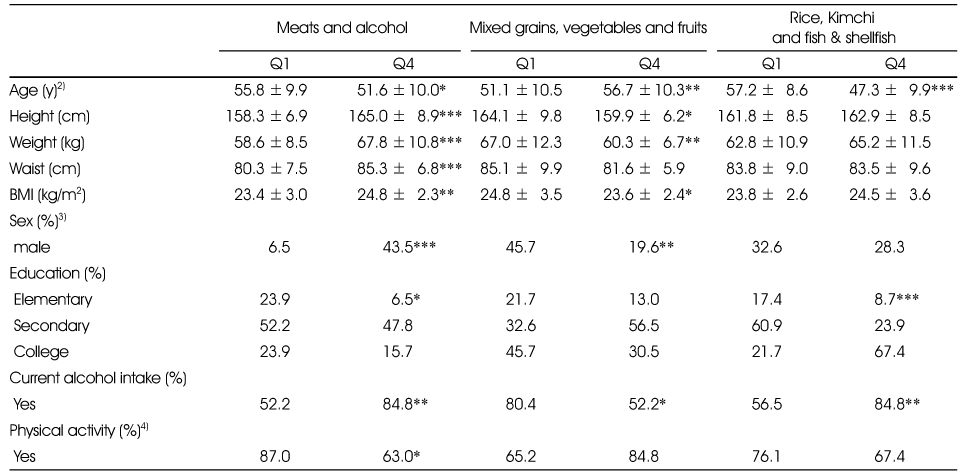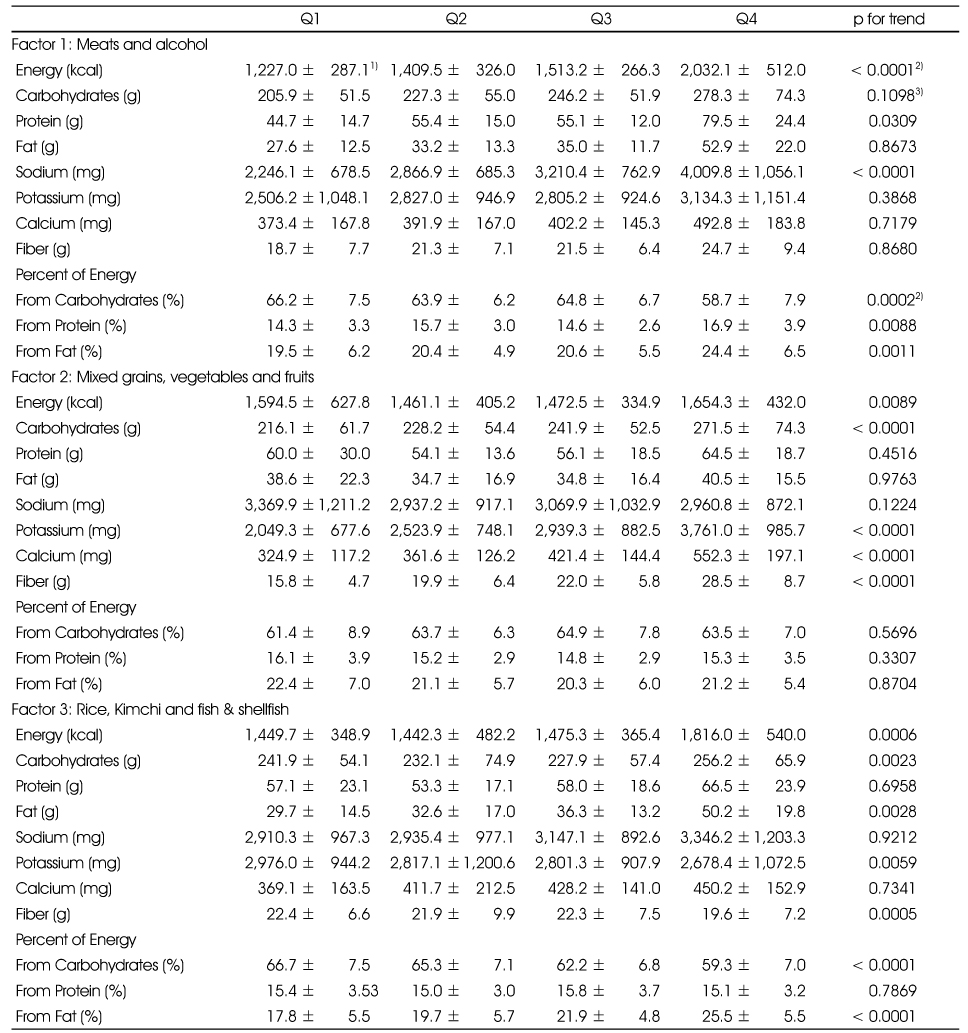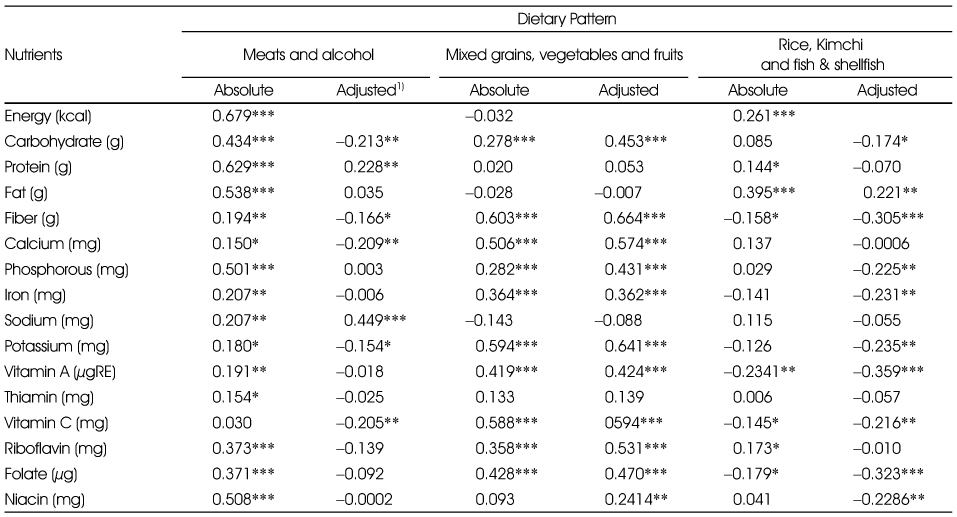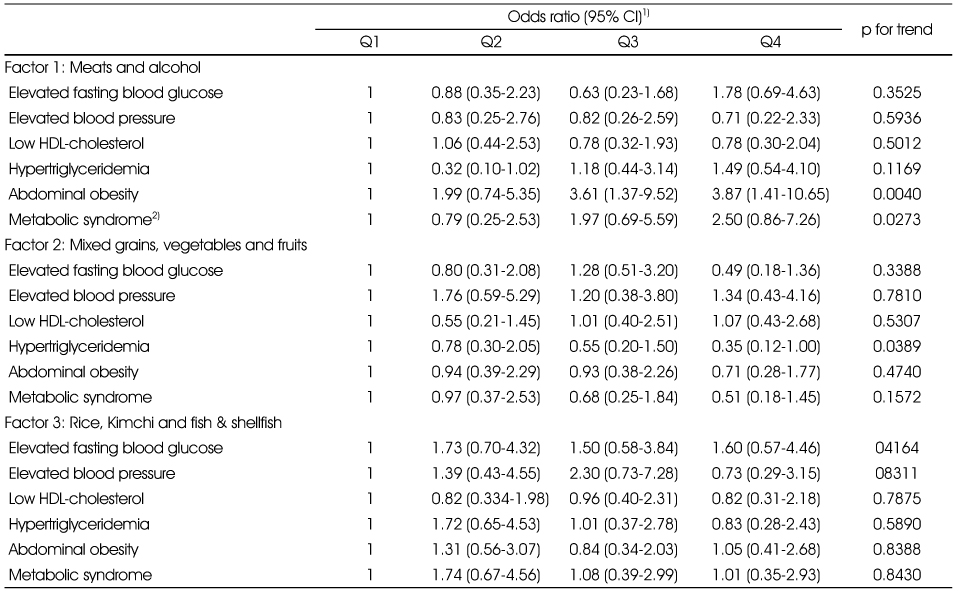Articles
- Page Path
- HOME > Korean J Community Nutr > Volume 19(6); 2014 > Article
-
Research Article
- The Risk of Metabolic Syndrome by Dietary Patterns of Middle-aged Adults in Gyeonggi Province
- You-Sin Lee, Moo-Yong Lee, Sim-Yeol Lee
-
Korean Journal of Community Nutrition 2014;19(6):527-536.
DOI: https://doi.org/10.5720/kjcn.2014.19.6.527
Published online: December 31, 2014
1Department of Home Economics Education, Dongguk University, Seoul, Korea.
2Cardiovascular Center, Dongguk University Ilsan Hospital, Goyang, Korea.
- Corresponding author: Sim-Yeol Lee. Department of Home Economics Education, Dongguk University, Seoul 110-715, Korea. Tel: (02) 2260-3413, Fax: (02) 2265-1170, slee@dongguk.edu
Copyright © 2014 The Korean Society of Community Nutrition
This is an Open-Access article distributed under the terms of the Creative Commons Attribution Non-Commercial License (http://creativecommons.org/licenses/by-nc/3.0/) which permits unrestricted non-commercial use, distribution, and reproduction in any medium, provided the original work is properly cited.
- 633 Views
- 0 Download
- 4 Crossref
Figure & Data
REFERENCES
Citations

- Association between the Korean Healthy Diet Score and Metabolic Syndrome: Effectiveness and Optimal Cutoff of the Korean Healthy Diet Score
Soo-Hyun Kim, Hyojee Joung
Nutrients.2024; 16(19): 3395. CrossRef - The Relationship between Meal Regularity and Oral Health and Metabolic Syndrome of Adults in Single Korean Households
Jin-Ah Jung, Hye-Won Cheon, On-Ju Ju
Journal of Dental Hygiene Science.2021; 21(3): 185. CrossRef - Metabolic Syndrome Risk by Dietary Fat Energy Ratio in Middle-aged Men - Using the 2012~2013 Korean National Health and Nutrition Examination Survey Data -
Eun-Sil Her
The Korean Journal of Food And Nutrition.2016; 29(6): 1030. CrossRef - Reduction of Plasma Triglycerides and Cholesterol in High Fat Diet-Induced Hyper-Lipidemic Mice by n-3 Fatty Acid from Bokbunja (Rubus coreanus Miquel) Seed Oil
Hyelin Jeon, Su-Jin Oh, Hyun Soo Nam, Yoon Seok Song, Kyung-Chul Choi
Journal of the Korean Society of Food Science and Nutrition.2015; 44(7): 961. CrossRef
Factor loading matrix for the 3 major dietary patterns according to intake amounts of food or food groups
Factor loadings less than ±0.20 are not shown for simplicity.
Comparison of characteristics by quartile scores of dietary patterns1)
BMI: Body mass index
1) Factor score of each subject for a given factor was obtained by the sum of products of factor loading and standardized score of each variable, 2) Mean±SD, tested by linear trend test using generalized linear model, 3) %, tested by chi-square test, 4) Physical activity was assigned "Yes" if subjects engaged in physical activity at least 2 days or more per week.
*: p < 0.05, **: p < 0.01, ***: p < 0.001
Nutrient intakes by quartile scores of dietary patterns
1) Mean±SD, 2) Adjusted for age, sex, 3) Adjusted for age, sex and energy intake
Correlation coefficients between nutrient intakes and scores of dietary patterns
1) Adjusted for age, sex and energy intake.
*: p < 0.05, **: p < 0.01, ***: p < 0.001
Odds ratios for metabolic syndrome and its components by quartile scores of dietary patterns
1) Odds ratios were adjusted by age, sex using logistic regression.
2) Serum fasting blood glucose ≥ 100 mg/dL; Systolic blood pressure ≥ 130 mm Hg or diastolic blood pressure ≥ 85 mm Hg; Low serum HDL cholesterol < 50 mg/dL for women or < 40 mg/dL for men; Serum TG ≥ 150 mg/dL; Waist circumference ≥ 85 cm for women or ≥ 90 cm for men.
Factor loadings less than ±0.20 are not shown for simplicity.
BMI: Body mass index 1) Factor score of each subject for a given factor was obtained by the sum of products of factor loading and standardized score of each variable, 2) Mean±SD, tested by linear trend test using generalized linear model, 3) %, tested by chi-square test, 4) Physical activity was assigned "Yes" if subjects engaged in physical activity at least 2 days or more per week. *: p < 0.05, **: p < 0.01, ***: p < 0.001
1) Mean±SD, 2) Adjusted for age, sex, 3) Adjusted for age, sex and energy intake
1) Adjusted for age, sex and energy intake. *: p < 0.05, **: p < 0.01, ***: p < 0.001
1) Odds ratios were adjusted by age, sex using logistic regression. 2) Serum fasting blood glucose ≥ 100 mg/dL; Systolic blood pressure ≥ 130 mm Hg or diastolic blood pressure ≥ 85 mm Hg; Low serum HDL cholesterol < 50 mg/dL for women or < 40 mg/dL for men; Serum TG ≥ 150 mg/dL; Waist circumference ≥ 85 cm for women or ≥ 90 cm for men.

 KSCN
KSCN





 PubReader
PubReader Cite
Cite


